The Edit panel provides a variety of tools for modifying polygon-based objects, including transform constraints, edge and loop creation, and editing texture coordinates.
Interface
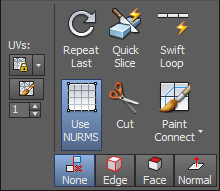
Edit panel on minimized ribbon

Edit panel on maximized ribbon
-
 Preserve UVs
Preserve UVs - When on, you can edit sub-objects without affecting the object's UV mapping. You can choose any of an object's mapping channels to preserve or not; see Preserve UVs Settings, following. Default=off.
Without Preserve UVs, there is always a direct correspondence between an object's geometry and its UV mapping. For example, if you map an object and then move vertices, the texture moves along with the sub-objects, whether you want it to or not. If you turn on Preserve UVs, you can perform minor editing tasks without changing the mapping.

Original object with texture map (left); Scaled vertices with Preserve UVs off (center); Scaled vertices with Preserve UVs on (right)
Tip: For best results with Preserve UVs at the vertex level, use it for limited vertex editing. For example, you'll usually have no trouble moving a vertex within edge or face constraints. Also, it's better to perform one big move than several smaller moves, as multiple small moves can begin to distort the mapping. If, however, you need to perform extensive geometry editing while preserving mapping, use the Channel Info utility instead. - Preserve UVs Settings (on Preserve UVs drop-down)
- Opens the Preserve Map Channels dialog, which lets you specify which vertex color channels and/or texture channels (map channels) to preserve. By default, all vertex color channels are off (not preserved), and all texture channels are on (preserved). Tip: You can open the Preserve Map Channels dialog quickly by Shift+clicking the Preserve UVs button.
-
 Tweak (UVs)
Tweak (UVs) -
When on, you can adjust the UVW mapping on your model directly in the viewport using a paintbrush-like tool by dragging over the vertices of the model to pull the texture vertices around. When active, the UV Tweak Options panel opens on the ribbon. You can use these settings to adjust the brush strength and other parameters.
By tweaking UVs with this tool you can quickly adjust areas of stretching in the UVW mapping without the need to add any modifiers. Use the spinner to choose the desired mapping channel and then start the tool. When finished tweaking, right-click to exit the tool.
To revert to untweaked UVs, paint with the Alt key held down. Other keyboard alternatives are covered in the UV Tweak Options topic.
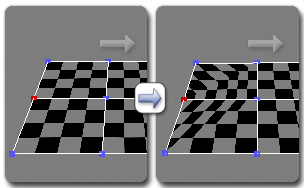
Drag a vertex to adjust the UVs
When working with Tweak, it’s useful to have a material applied to the model that enables you to easily spot stretching in the mapping. A checker map is suitable for this purpose.
Tip: To see the modified texture coordinates that result from using the Tweak tool, apply an Unwrap UVW modifier and then click the Edit button on the modifier’s Parameters rollout. -
 Repeat Last
Repeat Last - Repeats the most recently used command.
For example, if you extrude a polygon, and want to apply the same extrusion to several others, select the others, and then click Repeat Last.

You can apply a spline extrusion of a single polygon (left) repeatedly to other single polygons (1) or to multiple polygon selections, contiguous (2) or not (3).
Note: Repeat Last does not repeat all operations. For example, it does not repeat transforms. To determine which command will be repeated when you click the button, check the tooltip for the Repeat Last button on the command panel, which gives the name of the last operation that can be repeated. If no tooltip appears, nothing will happen when you click the button.Keyboard
 ; (semicolon) (3ds Max mode)
; (semicolon) (3ds Max mode) Keyboard
 G (Maya mode: See Interaction Mode Preferences.)
G (Maya mode: See Interaction Mode Preferences.) -
 QuickSlice
QuickSlice - Lets you quickly slice the object without having to manipulate a gizmo. Make a selection, click QuickSlice, and then click once at the slice start point and again at its endpoint. You can continue slicing the selection while the command is active.
To stop slicing, right-click in the viewport, or click QuickSlice again to turn it off.
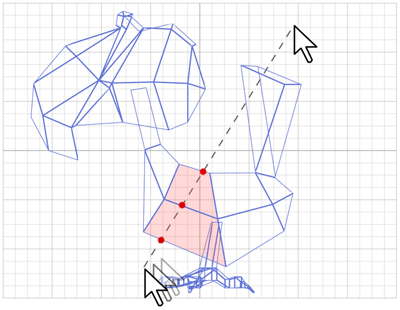
With Quickslice on, you can draw a line across your mesh in any viewport, including Perspective and Camera views. The mesh is sliced interactively as you move the line endpoint.
Note: At the Object level, QuickSlice affects the entire object. To slice only specific polygons, use QuickSlice on a polygon selection at the Poly sub-object level.Note: At the Polygon or Element sub-object level, QuickSlice affects only selected polygons. To slice the entire object, use QuickSlice at any other sub-object level, or at the object level. -
 SwiftLoop
SwiftLoop -
Place edge loops by clicking. Turn on, then click anywhere to insert an edge loop automatically, perpendicular to the edge closest to where you click. Continue clicking edges or right-click to exit.
Note: As you move the mouse cursor over the object surface, a real-time preview shows where the loop will be created when you click.Additional features include the ability to slide edges or edge loops in different ways. Following are the different functions of the tool, which depend on which keyboard keys are pressed:
- Shift Click to insert an edge loop and adjust the new loop to the flow of the surrounding surface.
- Ctrl Click to select an edge loop and automatically activate the Edge sub-object level.
- Alt Drag a selected edge loop to slide the edge loop between its bounding loops.
- Ctrl+Alt Same as Alt but also straightens out the loop (if necessary) when you start to drag.
- Ctrl+Shift Click to remove an edge loop.
Important: Alt+drag does not work as expected in Maya mode. In Maya mode, Alt+drag orbits a viewport (Perspective views only). -
 Use NURMS
Use NURMS -
Applies smoothing via the NURMS method and opens the Use NURMS Panel. As implemented in Edit/Editable Poly, NURMS is an easy-to-use, procedural mesh-smoothing method that gives you overall control over smoothing parameters.
You control the degree of smoothing with the main Iteration setting, and, optionally the Iteration setting in the Render group as well.
-
 Cut
Cut - Lets you create edges from one polygon to another or within polygons. Click at the start point, move the mouse and click again, and continue moving and clicking to create new connected edges. Right-click once to exit the current cut, whereupon you can start a new one, or right-click again to exit Cut mode.
While cutting, the mouse cursor icon changes to show the type of sub-object it’s over, to which the cut will be made when you click. The following illustration shows the three different cursor icons.
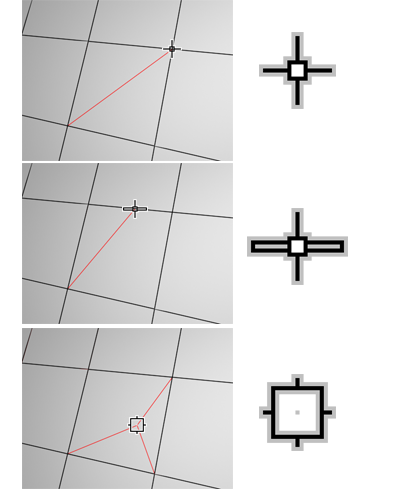
Top: Cutting to a vertex
Center: Cutting to an edge
Bottom: Cutting to a polygon
Cut is available at the object level and all sub-object levels.
Note: You can use Cut with Turn for enhanced productivity. For more information, see this procedure.Tip: While using Cut (between clicks), you can navigate the viewport interactively as follows:- To pan the viewport, scroll the mouse wheel or drag with the middle mouse button.
- To orbit the viewport, hold down Alt while scrolling the mouse wheel or dragging with the middle mouse button.
- To zoom the viewport, scroll the mouse wheel or hold down Alt+Ctrl and drag forward and back with the middle mouse button.
-
 Paint Connect
Paint Connect -
When on, you can paint connections interactively between edges and vertices.
Paint Connect offers a variety of operational modes, depending on which key or keys are pressed:
- Normal Drag to paint connections between edges.
- Shift Drag to paint connections between edges in the middle of the edges.
- Ctrl Drag to select and connect vertices.
- Alt Click to remove a vertex.
- Ctrl+Shift Click to remove an edge loop.
- Ctrl+Alt Click to remove an edge.
- Shift+Alt Drag to paint a double connection (two parallel edges) between edges.
Important: Alt+click does not work as expected in Maya mode. In Maya mode, Alt+drag orbits a viewport (Perspective views only).Tip: After using Paint Connect to create a loop that changes direction, you can “quadify” the corner polygons with Build Corner. - Set Flow (on Paint Connect drop-down)
-
When on, using Paint Connect automatically repositions new edges to fit the shape of the surrounding mesh.
-
 Constraints
Constraints - Lets you use existing geometry to constrain sub-object transformation. Choose the constraint type:
- None: No constraints. This is the default option.
- Edge: Constrains sub-object transformations to edge boundaries.
- Face: Constrains sub-object transformations to individual face surfaces.
- Normal: Constrains each sub-object’s transformations to its normal, or the average of its normals. In most cases, this causes sub-objects to move perpendicular to the surface. Note: This constraint works like the Push modifier, including the fact that it operates on unmodified base normals. Edited normals are unsupported.
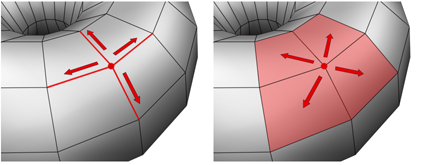
When set to Edge, moving a vertex will slide it along one of the existing edges, depending on the direction of the transformation. If set to Face, the vertex moves only on the polygon’s surface.
Note: You can set constraints at the Object level, but their use pertains primarily to sub-object levels. The Constraints setting persists at all sub-object levels.